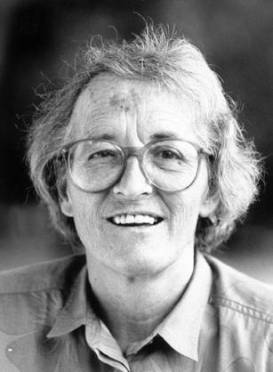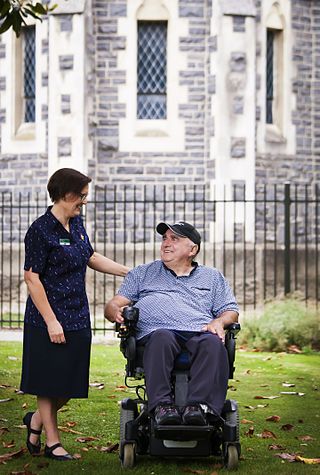Plot summary
The book contains ten short stories, the titles of each being associated with "gifts" which are various functions of the body, both physical and emotional: sweat, wholeness, tears, skin, hunger, mobility, death, speech, sight, hope, and mourning. The caregiver experiences each "gift", as he/she deals with patients who have AIDS, showing the different shared relationships in each case. Each patient is a distinct case, differing in terms of age, financial situation, attitude toward the illness etc., showing the reader that this disease affects all types of people.
Characters
The Caregiver
The gender of the caregiver is unknown, although it is hinted that it is a young adult who is still working on post-high-school education. The caregiver works for Urban Community Services (UCS), an organization that seems to be geared towards patients with AIDS. As the caregiver interacts with the patients, the reader witnesses their growing relationships. The caregiver is straightforward, almost blunt, in narrating the story, clearly illuminating the resulting emotions.
The book shows that the care between the narrator and her clients is mutual. For instance, the latter comfort the narrator when she learns that one of her close colleagues has been diagnosed with AIDS. Yet the book refuses to idealize the practice of caring. After all, readers see the narrator put herself aside for the people she cares for (calling and visiting clients during her time off from work), and watch her suffer from her strong emotional connection with them. "After a while, this intense involvement becomes untenable for the narrator, who starts to protect herself by creating some distance between her and the people she cares for (and whom she has to let go because they all ultimately die)." [3]
Rick
Rick is the AIDS patient of the first story. He shares a routine with the caregiver, who visits every Tuesday and Thursday, bringing coffee and cinnamon rolls to share. After Rick would answer the door, always with a "Hello! Just a minute!", the two would talk before the caregiver would clean the house. When the caregiver arrives one day and finds Rick curled up on the couch, not really responding, it is obvious that there is something wrong. He is shaking, saying he is cold, although his body is hot and bathed in sweat. The caregiver holds him until he can be taken to the hospital.
Mrs. Connie Lindstrom
Mrs Lindstrom is an old woman which whom the caregiver comes to care for deeply. Aside from the caregiver, Mrs Lindstrom is the most recurring character because of this relationship. She tries to be independent in taking care of herself, despite her illness, as seen in The Gift of Wholeness when she insists upon making the refreshments despite being totally out of breath throughout the whole process. She shares a close relationship with her three children, especially her son Joe. In The Gift of Mourning, it is Joe and the caregiver who are constantly at her side in her last moments.
Ed
Ed is an older man, whom the caregiver has tended to for some time at the beginning of the story. Ed has been accepted for a room at a local hospice after being on the waiting list for a long time, but when the time comes, he is unsure if he wants to accept it. In The Gift of Tears, he ends up not accepting the room, claiming that he has too much to do before he can move out. However, we find that he ends up in the hospice in The Gift of Mobility where he is respected and known as the man who turned down a room. When the caregiver comes to visit him, he seems to be adjusting well, but as the visits progress, the caregiver learns that Ed can't stand living in the hospice. He ends up leaving the hospice to go to the YMCA, but ends up leaving the Y on the same day, leading the caregiver to not know of his whereabouts. When the caregiver asks his friends at the hospice how he seemed when he left, they simply laugh and say "vertical".
Carlos
Carlos is middle aged and of Hispanic descent. The caregiver's interaction with this patient is minimal until bathtime. In the process of getting Carlos undressed, the condom part of his catheter is exposed, much to his embarrassment, but the caregiver remains casual and calm for his sake. The bath calms Carlos; the cleansing of his skin acting as a soothing ritual.
Marty
Marty is a young adult whom the caregiver meets while visiting Carlos, as the two had long been close friends. After Carlos' death, the caregiver again encounters Marty but fails to recognize him, his appearance having changed drastically from essentially fat to drastically thin. The two discuss Carlos, and it is revealed that Marty played a part in his friend's death because he hated to see him suffer through the pain, telling the caregiver that he "gave him the gift of death."
Mike
Mike is not on the caregiver's usual visitation list, but one day Mike's usual caregiver, Roger, is unavailable and our narrator fills in. Throughout the visit, Mike is constantly comparing what the caregiver does to what Roger does, revealing the close nature of his relationship with Roger. This leads the caregiver to tell Mike that he is very important to Roger, an act that the caregiver feels makes all the difference with Mike.
Keith
Keith is the most-repellent-appearing case, according to the caregiver, who describes the process of placing salve on Keith's body sores as an ordeal that must be done calmly and without hesitation, in order to avoid embarrassing the patient. One day, as the caregiver is rubbing the salve in, Keith tells the story behind a painting in the room, which was painted in Africa. Keith says that he lived in Africa for some time, which his mother thought was a good thing, until he contracted AIDS and had to return to the States. He and another patient (Connie) are the only patients with whom the caregiver is actually present at the time of their deaths.
Margaret
Margaret is a long-time UCS supervisor, who shares many experiences with the caregiver during the years. However, Margaret has contracted AIDS herself, and has had to leave her position with the company. This causes an emotional response from everyone in the organization. When the caregiver asks Margaret if she desires anything, she replies, "You can hope again."
Palliative care is an interdisciplinary medical caregiving approach aimed at optimizing quality of life and mitigating suffering among people with serious, complex, and often terminal illnesses. Within the published literature, many definitions of palliative care exist. The World Health Organization (WHO) describes palliative care as "an approach that improves the quality of life of patients and their families facing the problems associated with life-threatening illness, through the prevention and relief of suffering by means of early identification and impeccable assessment and treatment of pain, illnesses including other problems whether physical, psychosocial, and spiritual". In the past, palliative care was a disease specific approach, but today the WHO takes a broader patient-centered approach that suggests that the principles of palliative care should be applied as early as possible to any chronic and ultimately fatal illness. This shift was important because if a disease-oriented approach is followed, the needs and preferences of the patient are not fully met and aspects of care, such as pain, quality of life, and social support, as well as spiritual and emotional needs, fail to be addressed. Rather, a patient-centered model prioritizes relief of suffering and tailors care to increase the quality of life for terminally ill patients.
HIV-positive people, seropositive people or people who live with HIV are people infected with the human immunodeficiency virus (HIV), a retrovirus which if untreated may progress to acquired immunodeficiency syndrome (AIDS).
Terminal illness or end-stage disease is a disease that cannot be cured or adequately treated and is expected to result in the death of the patient. This term is more commonly used for progressive diseases such as cancer, dementia, advanced heart disease, and for HIV/AIDS, or long COVID in bad cases, rather than for injury. In popular use, it indicates a disease that will progress until death with near absolute certainty, regardless of treatment. A patient who has such an illness may be referred to as a terminal patient, terminally ill or simply as being terminal. There is no standardized life expectancy for a patient to be considered terminal, although it is generally months or less. Life expectancy for terminal patients is a rough estimate given by the physician based on previous data and does not always reflect true longevity. An illness which is lifelong but not fatal is a chronic condition.

Elisabeth Kübler-Ross was a Swiss-American psychiatrist, a pioneer in near-death studies, and author of the internationally best-selling book, On Death and Dying (1969), where she first discussed her theory of the five stages of grief, also known as the "Kübler-Ross model".

Dame Cicely Mary Strode Saunders was an English nurse, social worker, physician and writer. She is noted for her work in terminal care research and her role in the birth of the hospice movement, emphasising the importance of palliative care in modern medicine, and opposing the legalisation of voluntary euthanasia.
Death education is education about death that focuses on the human and emotional aspects of death. Though it may include teaching on the biological aspects of death, teaching about coping with grief is a primary focus. The scientific study of death is known as thanatology. Thanatology stems from the Greek word thanatos, meaning death, and ology meaning a science or organized body of knowledge. A specialist in this field is a thanatologist.
Residential care refers to long-term care given to adults or children who stay in a residential setting rather than in their own home or family home.

Jeanie Boulet is a fictional character from the television series ER. The role was portrayed by Gloria Reuben who debuted as a recurring character in the first season episode, "Long Day's Journey", aired on January 19, 1995. Reuben was promoted to the role of series regular as of the second season episode, "Days Like This", aired on November 2, 1995 and made her last regular appearance in the sixth season episode, "The Peace of Wild Things", aired on November 11, 1999.

A caregiver, carer or support worker is a paid or unpaid person who helps an individual with activities of daily living. Caregivers who are members of a care recipient's family or social network, and who may have no specific professional training, are often described as informal caregivers. Caregivers most commonly assist with impairments related to old age, disability, a disease, or a mental disorder.
Family caregivers are "relatives, friends, or neighbors who provide assistance related to an underlying physical or mental disability for at-home care delivery and assist in the activities of daily living (ADLs) who are unpaid and have no formal training to provide those services."
Rebecca Brown is an American novelist, essayist, playwright, artist, and professor. She was the first writer in residence at Richard Hugo House, co-founder of the Jack Straw Writers Program, and served as the creative director of literature at Centrum in Port Townsend, Washington from 2005 to 2009. Brown's best-known work is her novel The Gifts of the Body, which won a Lambda Literary Award in 1994. Rebecca Brown is an Emeritus faculty member in the MFA in Creative Writing Program at Goddard College in Plainfield, Vermont and is also a multi-media artist whose work has been displayed in galleries such as the Frye Art Museum.
Caregiver syndrome or caregiver stress is a condition that strongly manifests exhaustion, anger, rage, or guilt resulting from unrelieved caring for a chronically ill patient. This condition is not listed in the United States' Diagnostic and Statistical Manual of Mental Disorders, although the term is often used by many healthcare professionals in that country. The equivalent used in many other countries, the ICD-11, does include the condition.
An informal or primary caregiver is an individual in a cancer patient's life that provides unpaid assistance and cancer-related care. Caregiving is defined as the processing of assisting someone who can't care for themselves, which includes physical, mental, emotional, social, and spiritual needs. Due to the typically late onset of cancer, caregivers are often the spouses and/or children of patients, but may also be parents, other family members, or close friends. Taking care of family members at home is a complicated experience. The relationships involved constantly shift and change, in expected and unexpected ways. The expected or expected changes can negatively affect physical health, emotions, social life, and spiritual well-being of the caregiver. Informal caregivers are a major form of support for the cancer patient because they provide most care outside of the hospital environment. This support includes:
Carol Levine is a home health-care advocate and the Director of the Families and Health Care Project of the United Hospital Fund.

Death trajectory refers to the pattern of dying when a patient is given a projected death date with limited or no medical recourse for the remaining existence of the individual's life. The death trajectory is dependent on the cause of death, whether it is sudden death, chronic illness, or the steady decline in health due to senescence (aging). Death trajectory is analyzed in two separate aspects: duration and shape. Duration refers to the period of time a patient has to live, which can be anywhere from imminent death to several months. Shape refers to how that duration is then graphed. In other words, the shape is "the course of dying, its predictability, and whether death is expected or unexpected".
Lucy Finch is a palliative nurse who has worked in several African countries and founded a hospice in Malawi – Ndi Moyo – "the place giving life".
The San Francisco model of AIDS care began in 1983 in wards 86 and 5B of San Francisco General Hospital. The focus of this model was not only on the health of each patient with AIDS, but also on the well-being of each person. As AIDS was beginning to be treated as a significant epidemic, San Francisco General Hospital recognized the need to create new standards of care for a disease that had never before been experienced. Compassionate care has now become a priority worldwide and an expected standard in hospitals as there places a greater emphasis on the social, psychological, and economic aspects of treatment in addition to the medicine.
Margaret Ruth McCorkle FAAN, FAPOS was an American nurse, oncology researcher, and educator. She was the Florence Schorske Wald Professor of Nursing at the Yale School of Nursing.
Prasanna Nair is an Indian-born doctor working in the United States. She works in primary health care with a specialty in pediatric endocrinology.
The Gift of Peace AIDS Hospice is an AIDS hospice care home that was opened in 1986 by Mother Teresa and the Missionaries of Charity in Northeast Washington, D.C.





